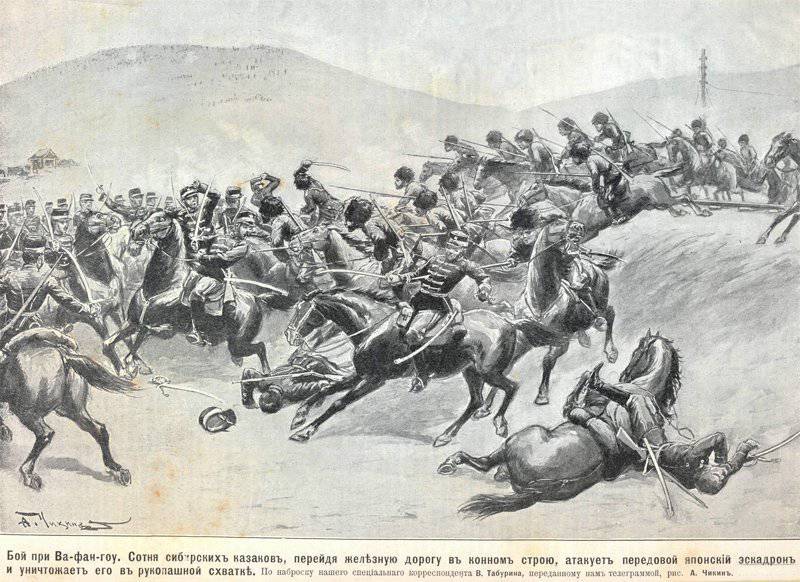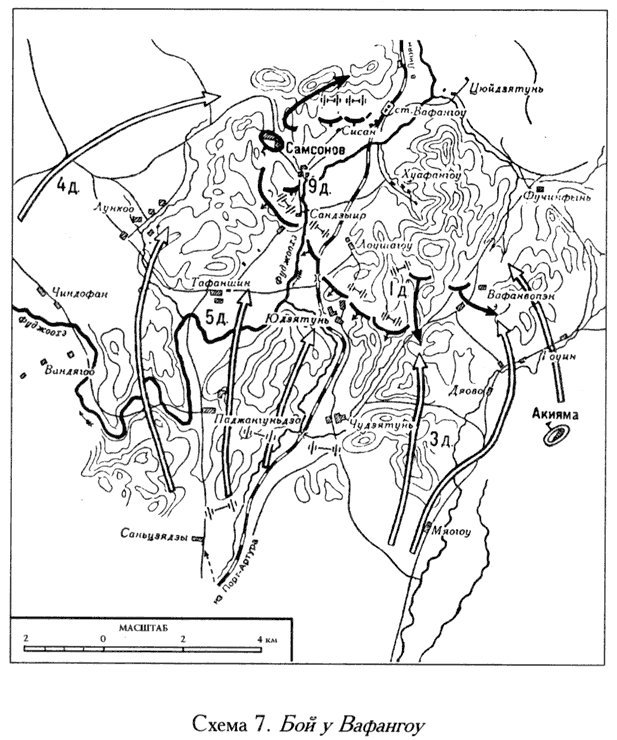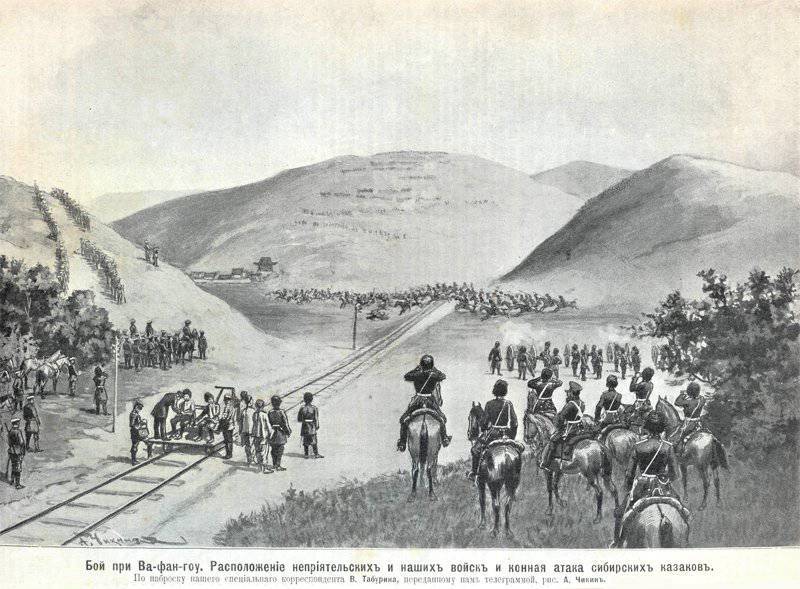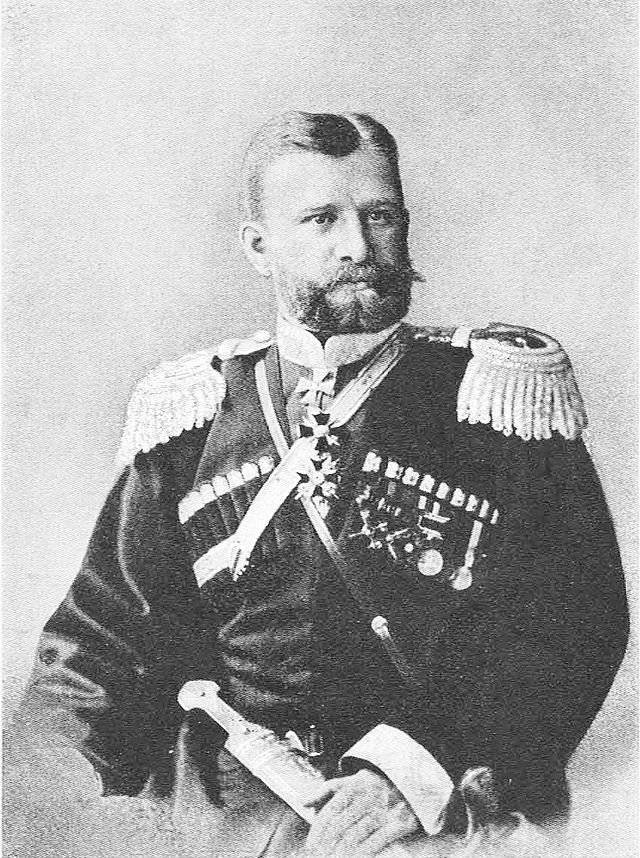Fight at Wafangou

1 — 2 June 1904, the battle took place at Wafangow. The success of the Japanese at Yalu (Battle of the Yalu River) and the Kwantung Peninsula, which endangered Port Arthur, forced the supreme command to put pressure on the commander of the Manchurian army, Kuropatkin, who, given the current operational situation, considered it very risky to take any measures to support Port Arthur until the corresponding reinforcement of his army. The task of liberating Port Arthur from the blockade was assigned to the 1 of the Siberian Corps.
The situation before the fight. Forces of the parties
The landing of the Japanese troops on the Kwantung Peninsula and the success of the Japanese 2 Army during the battle of Jinzhou (Fight jinzhou), created a threat to Port Arthur. The Manchurian army and the garrison of Port Arthur missed the opportunity to disrupt the Japanese troops or defeat the enemy from Jinzhou.
However, the high command was displeased with the situation. The first defeats caused discontent of the public, which had been stuffed with patriotic tales about the power of the Russian Empire and the weakness of Japan. Urgently needed a victory. Minister of War Sakharov sent a letter to Kuropatkin expressing concern for the fate of the Port Arthur Fortress, the loss of which “will be a new and most severe blow that will undermine both the political and military prestige of Russia not only in the Far East, but also in the Middle East Asia and in Europe. " Sakharov noted that our enemies will take advantage of the defeat of Russia, and "friends will turn away from Russia as an impotent ally."
On May 18, the commander-in-chief of the Russian forces in the Far East, Admiral Alekseev, gave Kuropatkin a directive on the preparation of an attack on the Port Arthur revenues, proposing to conduct operations immediately and with forces of up to four divisions (48 battalions). It must be said that under the current operational environment, Kuropatkin believed that such risky actions should not be taken. The movement of the Manchurian army to the south allowed the Japanese to enter the messages of the Russian troops, which put Kuropatkin’s army in an extremely difficult position. However, his considerations were not taken into account.
The task of saving Port-Arthur was assigned to the 1 of the Siberian Corps under the command of Lieutenant-General Baron Georgiy Karlovich Stakelberg. Shtakelberg was a member of the Khiva campaign 1873 of the year, the Kokand expedition, the Russian-Turkish war 1877-1878, the Chinese campaign 1900-1901. and had a reputation as a brave commander. The corps included 1 and 9 East Siberian rifle divisions, reinforced by the 2 brigade of the 35 infantry division, the Tobolsk Regiment, two sapper companies and several cavalry and artillery units. On the way to the corps, advanced cavalry detachments joined, which formed a consolidated Cossack division (Siberians and Trans-Baikals, the Primorsky Dragoon Regiment). In total, under Shtakelberg, there were 33 thousand people, 96 guns. The fact that only Shtakelberg’s corps was sent for the Port Arthur’s de-blockade says that Kuropatkin considered Alekseev’s order impracticable.
Stackelberg received the task of advancing in the direction of Port Arthur to pull off the greatest possible forces of the Japanese army. If successful, seize the Jinzhou position and advance to Port Arthur. Putting such broad and far-reaching tasks, Kuropatkin simultaneously attributed to Shtakelberg: “With superior forces, not to bring matters to a decisive collision and to prevent at all the expenditure of our entire reserve in battle.” Thus, the commander of the 1-Siberian Corps received dual instructions. On the one hand, in the event of a first success, it was supposed to free Port Arthur, on the other hand, not to engage in a decisive battle with the superior forces of the enemy and not to spend the reserve. It must be said that earlier similarly contradictory instructions were received by Zasulich on Yalu and Stoessel - on Jinzhou.
Russian troops opposed 2-I Japanese army under the command of Yasukata Oku. The army consisted of 3-I, 4-I and 5-I infantry divisions (48 battalions), 1-I separate cavalry brigade, just up to 40 thousand people and 216 guns. The Japanese army had a great superiority in artillery weapons (almost 2,5 times). Thus, the Japanese army consisted of 3, 4 and 5 regiments of the divisional, 13, 14 and 15 regiments of army artillery.

Map source: N. Levitsky. Russian-Japanese War 1904-1905
Battle
The Japanese command expected the Russians to try to help Port-Arthur surrounded from the sea and land. Therefore, after the battle at Jinzhou, the Japanese did not pursue the Russian regiments departing for Port Arthur. The army of the Oka, fearing for its rear, from the side of Manchuria, left a barrier against Port Arthur and turned against the Russian Manchurian army. 25 May General Oku received an order from Marshal Iwao Oyama to advance north. Japanese advanced forces occupied the Wafangou station.
The Russian avant-garde threw the advanced units of the Japanese army 2 and occupied the Wafangou railway station. Stackelberg, having received news of the appearance of large enemy forces, decided to give a defensive battle near Vafango. The 1 Siberian Corps took up defenses in a position about 12 km long. The defensive position was divided into three sections, with 10 infantry battalions left in the corps reserve. The right flank was covered by a cavalry detachment under the command of General Samsonov, the left flank was covered with two rifle companies and cavalry patrols.
The position was chosen poorly - in front of it lay the hilly terrain that dominated the terrain. In addition, the Japanese command had every opportunity to bypass and grip the Russian positions. The Russian command repeated the mistakes that had already appeared in the course of the previous battles. So, artillery batteries were located in open positions. Lieutenant-General Shtakelberg personally ordered to put batteries on the tops of the hills and forbade the use of closed positions for the enemy, using outdated reports on artillery fighting. The batteries were open, were not disguised, which allowed the Japanese to quickly find them. Russian infantry on the hills has not prepared any trenches or shelters.
The commander of the 2 of the Japanese army, General Yasukata Oka, decided to strike at the center of the Russian position with the forces of the 3 th infantry division, the right flank was to attack the 5-I infantry division. The 4 Division received the task of making a detour by 25 kilometers bypassing the right flank of the Russian corps and cutting off its path to withdrawal. The cavalry brigade, under the command of General Yoshifuru Akiyama, was to enter the Russian rears from the left Russian flank.
The Japanese offensive began with strong artillery preparation. This immediately led to serious losses of the Russian infantry, which did not prepare normal shelters. Significant losses suffered and the Russian artillery, which stood in open positions on the tops of the hills. After that, the Japanese infantry went on the attack, and the cavalry brigade, bypassing the left flank. On the first day of the battle at Wafangou, all Japanese attacks were successfully repulsed. The decisive role was played by the 2 th East Siberian Rifle Regiment, which, after the 4-hour battle, was abandoned by the Japanese regiment attacking it, which retreated to its original positions. At nightfall, the skirmish subsided.
2 June both sides were set to attack. General Oku adhered to the previous plan. Stackelberg also planned to go on the offensive. Kuropatkin initially supported him and sent the Tobolsk Infantry Regiment. Due to the poor organization of intelligence, the Russian command did not know about the enemy’s maneuver roundabout. The commander of the 1 Siberian Army Corps did not know that his position at Wafangou was being bypassed by an enemy division. Considering that he had two enemy divisions in front of him, he was about to launch a counterattack. However, disagreements arose at the corps headquarters, and General Ivanov, the head of the headquarters, refused to issue an order for an attack. As a result, the troops who were waiting for the order to launch the offensive did not receive it. As a result, the commanders were forced to act according to the situation, not having a plan of action. The attacking actions of the 1 th East Siberian Rifle Division and the brigade of the 35 Infantry Division were easily repulsed by the Japanese, who had an advantage in artillery. In addition, during the battle, Shtakelberg received a new directive from Kuropatkin, which reported that in case of victory in this battle, the enemy cannot be pursued, since Kuroki's 1 Army can cut corps communications with the main forces of the Manchurian army. This did not add resolve to Stackelberg.
The appearance of the 4 Division led to a radical change in the situation. Early in the morning, the Cossack patrol reported the appearance of significant enemy forces in the south-western direction. However, no action was taken. Only when the Japanese division began an offensive in the area of the corps reserve and reserve artillery, was the headquarters convinced that the enemy division was heading off to the rear. It was no longer possible to undertake anything effective in such conditions. There was no time for the regrouping of troops and artillery, in the conditions of the onset of three enemy divisions. The troops began to retreat, being subjected to enemy shelling. The retreat was covered by the 8 th Tobolsk infantry regiment, which had just arrived by rail. The Japanese did not pursue the retreating Russian troops.

Results
The delayed operation to support Port Arthur failed. Moreover, she no longer had much meaning. The troops needed to be advanced at a time when the 2 I Oka Army was preparing to attack the Jinzhou position. Now Jinzhou was lost, Stoessel’s troops retreated to Port Arthur and could not support the Shtakelberg corps. Oku's 2 Army was already moving north, and Kuroki 1 Army and parts of Nozu's future 4 Army were threatening from the east. If the command wanted to crush the 2 Army, it was necessary to strengthen the 1 Siberian Corps of Baron Shtakelberg.
In 2-day battles at Wafangou, Russian troops lost more than 3,5 thousand people killed, wounded and missing. 17 guns were lost. The loss of the Japanese army - about 1,2 thousand. People. The high losses of the Russian army were caused by the lack of field fortifications.
Militarily, the success of the Japanese was due to several factors. Firstly, these include the offensive actions of the 5 Division and the Akiyama Cavalry Brigade, the detour movement of the 4 Division.
Secondly, these are the mistakes of the Russian command. Intelligence was poorly organized and did not reveal the 4 division bypass maneuver. The headquarters acted hesitantly, could not organize offensive corps actions. Although the ability to defeat the enemy existed. Bad things were with the use of artillery. Part of the artillery left in reserve and did not use. Artillery was placed in open positions, which made it possible for the Japanese to quickly identify the Russian batteries and suppress them. Similarly, the situation with the Russian cavalry was unsatisfactory. The cavalry detachment on the right flank retreated prematurely, creating a breach. The cavalry missed the appearance of a whole enemy division. The infantry did not have modern field fortifications that would protect it from enemy fire. The outdated redoubts, which were nevertheless erected, did not meet modern requirements, did not give adequate shelter from enemy fire. The Japanese called them "toy fortifications."
Thirdly, the inconsistency and indecision of the high command. A Russian military diplomat, Lieutenant-General A. A. Ignatiev, who participated in the war in Manchuria, noted in his memoirs “Fifty years in the ranks”: “The Battle of Wafangou revealed one of the main flaws in the education of the higher commanders: lack of mutual support ranks. "
It is worth noting that the Japanese also made a number of serious mistakes that did not allow them to achieve a more decisive success. The sluggishness of the 4 division’s bypass movement allowed the Russian corps to retreat quite calmly. The Japanese could not organize the persecution of Russian troops. With more skillful actions of the Japanese army, the Russian corps would not have avoided a decisive defeat.

George Karlovich Shtakelberg
Information